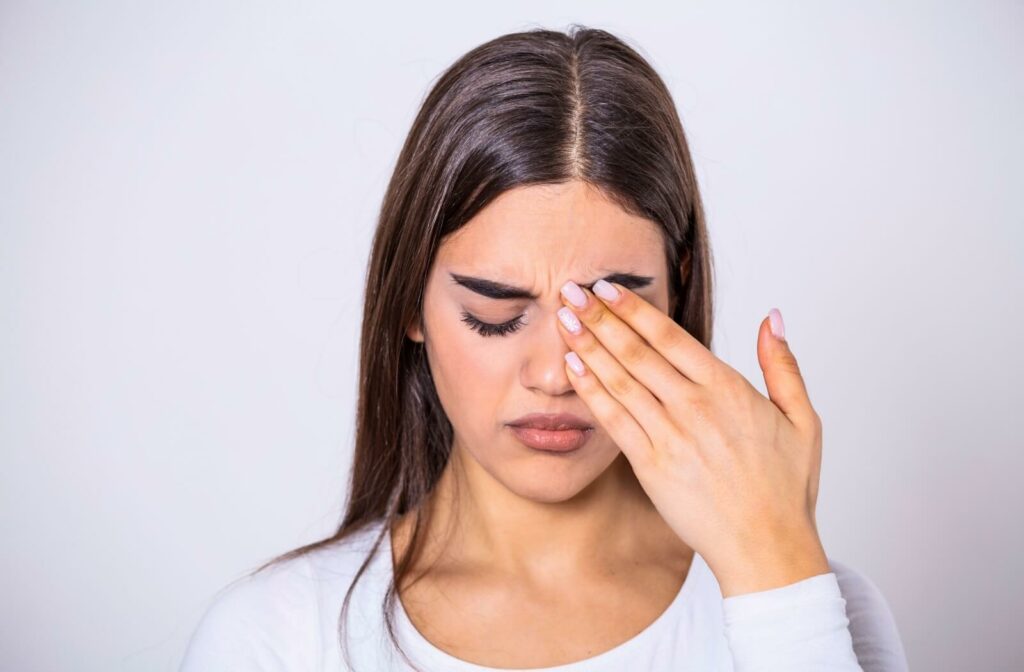A stye is a common eye infection caused by bacteria that occurs when eyelid glands become clogged.
To help promote healing, it’s encouraged to avoid wearing makeup. Wearing makeup with a stye can lead to further irritation and discomfort. This can cause the infection to last longer and lead to bacteria transfer.
If your stye isn’t going away, visiting your optometrist can help promote and encourage healing.
What is a Stye?
A stye is a small red lump, similar to a pimple, that can form on the inside or outside of the eyelid. They can be very painful and irritating.
A stye is a localized infection in the eyelid, which can make the eyelid red, swollen, and tender to the touch. They form when an oil gland or eyelash follicle becomes clogged with dead skin cells, oil, and other debris.
There are two types of styes:
- External Styes: Form at the base of an eyelash, starting as a pimple or a very tender red lump. This is usually caused by an infection in the eyelash follicle.
- Internal Styes: Form on the inside of the eyelid. This is caused by an infection in the inner eyelid gland that produces oil to keep the eyelid hydrated and moisturized.
While styes are painful and uncomfortable, they won’t affect your ability to see clearly.
Symptoms of a Stye
Styes can develop slowly before developing into painful, noticeable red bumps on the eyelid. Before a stye fully develops, you may experience slight discomfort when blinking.
Symptoms of a stye include:
- Eyelid pain
- Light sensitivity
- Watery eyes
- Yellow discharge
- Crusting of the eyelid with pus
- Redness, tenderness, and swelling of the eyelid
Risk Factors for Developing a Stye
Styes are very common and develop in both adults and children. Risk factors that increase the risk of developing a stye include:
- Touching your eyes with unwashed hands
- Poor contact lens handling and care
- Leaving your makeup on overnight
- Using old or expired makeup
- Blepharitis, a common eye condition that leads to irritated and swollen eyelids
- Meibomian gland dysfunction (MGD)
Can you Wear Makeup with a Stye?
Covering a stye with makeup is not recommended. Wearing makeup around the stye can cause the infection to last longer and lead to increased irritation and discomfort. Makeup can linger on the infected eyelid, meaning lash follicles can become increasingly clogged.
A common concern for patients is whether makeup can cause styes. Makeup can potentially contribute to the conditions that lead to a stye, but it’s not usually the sole cause.
Factors like leaving your makeup on overnight and wearing old and expired makeup can increase the risk of styes developing. Makeup that isn’t removed overnight can lead to increased bacteria on the eyelid. Old makeup can lead to redness, irritation, clogged pores, lash follicles, and bacteria growth.
To help prevent styes and other forms of eye and skin irritation, be mindful of the expiry dates on your makeup. Using expired eye makeup near the eye leads to an increased risk of spreading bacteria.
In the event of a stye, it’s advised to throw away makeup products that may be contaminated with bacteria and thoroughly clean your makeup applicators. Reusing contaminated products and applicators can cause styes to reform. Avoid sharing makeup products to reduce the risk of bacteria transfer between users.
How to Treat a Stye
A stye usually lasts about 1 to 2 weeks and usually goes away on its own. To help promote healing, try using a warm compress to massage the eyelid area:
- Warm Compress Massage: Apply a clean, warm washcloth to the eye for 10 to 15 minutes, several times a day. This can help the stye drain on its own. Gently massage the area to promote drainage. Don’t apply pressure.
- Keep the Area Clean: Use mild soap and warm water to clean the area twice a day.
If your stye does not go away after 2 weeks or becomes increasingly painful, visit your optometrist. Medical intervention with your optometrist may include:
- Antibiotics: Your optometrist may prescribe topical or oral antibiotics to clear the bacterial infection.
- Incision and Drainage: If the stye persists and becomes a chalazion your optometrist may drain the pus.
How to Prevent a Stye
There are several ways to prevent the formation, transfer, and spread of bacteria that can form a stye:
- Remove eye makeup every night: Use a gentle makeup remover to thoroughly clean the eye area and remove any makeup at the end of your day.
- Regularly replace eye makeup: Mascara and other eye makeup have a relatively short shelf life once opened. Replace these products every three to six months to avoid contact with bacteria.
- Do not share makeup: Sharing makeup is a definite no-no when you or someone you know is experiencing a stye or other ocular conditions, as you can easily transfer bacteria or viruses.
- Avoid rubbing your eyes: This can transfer bacteria and irritants to your eyes.
- Wash your hands: Always wash your hands before touching your face or applying any eye treatment or medication.
- Maintain a clean environment: Dust and pet dander can contribute to eye irritation. Keep your living spaces clean and consider air purifiers if necessary.

Schedule a Visit With Us!
While styes are a common eye condition that can be healed on their own, to help promote healing, or in the event of further irritation, visit your optometrist. Schedule a visit with our team at Total Vision for any questions related to your eye health!



